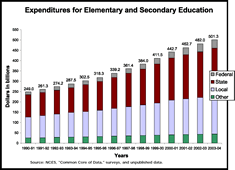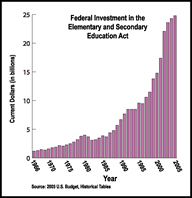|
|
 |
|
|
|
|
 |
|
The U.S. Constitution leaves the responsibility for public K-12 education with the states.
Because the U.S. Constitution does not designate a public education role for the federal government, responsibility for K-12 education falls to the states. However, because there is a compelling federal interest in the quality of the nation's public schools, the federal government, through the legislative process, provides assistance to the states and schools in an effort to supplement, not supplant, state support. The primary source of federal K-12 support began in 1965 with the enactment of the Elementary and Secondary Education Act (ESEA).
ESEA authorizes grants for elementary and secondary school programs for children of low-income families; school library resources, textbooks, and other instructional materials for school children; supplemental education centers and services; strengthening state education agencies; and education research and research training.
The No Child Left Behind Act of 2001 (NCLB) is a reauthorization of ESEA. The law's express purpose is to close the achievement gap through accountability, research- based instruction, flexibility and options for parents, so that no child is left behind. Total taxpayer investment in K-12 education in the United States for the 2003-04 school year is estimated to exceed $501.3 billion. 
Even in this current time of war, taxpayer investment in education exceeds that for national defense. In addition to the K-12 money mentioned above, taxpayers will spend an estimated $350.8 billion for higher education in the same school year.[ * ] As noted on the chart below, the United States is a world leader in education investment. However, nations that spend far less achieve higher levels of student performance.
States and localities are the primary sources of K-12 education funding and always have been. 
In the 2003-04 school year, 83 cents out of every dollar spent on education came from the state and local levels (46 percent from state funds and 37 percent from local governments). The federal government's share was 8.2 percent. The remaining 9 percent was from private sources, primarily for private schools. This division of support remains consistent with our nation's historic reliance on local control of schools. The federal share of K-12 spending has risen very quickly, particularly in recent years.
In 1990-91, the federal share of total K-12 spending was just 5.7 percent. Since that time, it has risen by more than one-third to 8.2 percent. Further, the historic federal funding increases since 2001 are only now reaching the classroom. Total education funding has increased substantially in recent years at all levels of government, even when accounting for enrollment increases and inflation. 
National K-12 education spending has increased 101 percent since 1990-91, 48 percent since 1996-97, and 22 percent since the 1999- 2000 school year. When this is calculated on a per-pupil basis and is adjusted for inflation, funding has increased: 7 percent in the last 3 years for which data is available, 15 percent over 5 years, and 21 percent over 10 years. Federal funding for two main federal K-12 programs will increase $9.3 billion since 2001 under the president's proposed budget for fiscal year (FY) 2005.
Sixty-three percent of the U.S. Department of Education's elementary and secondary school funds would go to help schools with economically disadvantaged students (ESEA Title I) and to support children with disabilities (Individuals with Disabilities Education Act [IDEA] Part B). If the president's FY 2005 request is enacted, the increases in these programs will have substantially exceeded any previous increases since their creation. Most federal funds are sent directly to states and local school districts for their use in schools. 
The president's FY 2005 budget would provide $38.7 billion for K-12 education. Of that amount, 95 percent would be distributed either directly to local districts or to schools through their states. Individual schools then use these funds for the purposes defined in the programs.
- ESEA Title I: $13.3 billion
- IDEA Part B: $11.1 billion
- Improving Teacher Quality: $2.9 billion
- English Language Learners: $587.4 million
- Impact Aid (schools impacted by military bases and other facilities): $1.2 billion
- Vocational Education (skills training): $1 billion
There are no federal education "mandates." Every federal education law is conditioned on a state's decision to accept federal program funds.
Despite the occasional use of the term "mandate" when discussing federal program obligations, there is no federal "mandate" to do anything in local schools. All obligations are conditions placed on the receipt of federal funds. Any state that does not want to abide by these requirements need not accept the federal grant money. While most states choose to use the federal funds, a few states in the past have forgone federal funds for various reasons. The federal commitment to education can be found in actual dollars earmarked to spend for education. 
Like all laws passed by Congress, many federal education statutes include limits on how much future Congresses can spend. These are called "authorization caps." Actual amounts spent on education are called "appropriated levels," which is the actual federal commitment to education. Authorization caps are occasionally claimed to be "promises" or "goals" for federal education spending. Failure to meet these levels is sometimes claimed to demonstrate that an "unfunded mandate" exists.
The claim is simply untrue. In the history of the United States, actual appropriations have rarely matched authorization levels. If this were the standard, nearly all federal programs supporting agriculture, health, safety, construction, job training and transportation would be below their congressional "goals." Overview of major federal K-12 education legislation and programs.

The No Child Left Behind Act (NCLB). NCLB gives our schools and our country groundbreaking education reform, based on stronger accountability for results, more flexibility for states and communities, encouraging proven education methods and more options for parents. Passed with bipartisan support in Congress and signed by President Bush on Jan. 8, 2002, the law represents the most comprehensive revision of federal education programs since the passage of the Elementary and Secondary Education Act of 1965. Using figures from the president's FY 2005 proposed budget, NCLB programs include:
- Title I. The largest federal K-12 program would provide over $13 billion to local districts to improve the academic achievement of children in high-poverty schools.
- Reading First. Would supply over $1.1 billion to states to promote the use of scientifically based research to provide high-quality reading instruction for grades K-3.
- Improving Teacher Quality Grants. Would provide states with $2.9 billion for teacher professional development and training.
- English Language Acquisition. Assists schools in improving the education of limited English-proficient children so that they can teach children to learn English and meet state academic standards.
- Other NCLB programs. Includes those to support charter schools; to support safe and drug-free schools; to improve math and science education; to support after-school learning programs; to assist American Indian, Alaska Native, and migrant students; and to support the use of education technology.
Individuals with Disabilities Education Act (IDEA). IDEA assists states and local schools in educating children with disabilities. Part B, the second largest federal K-12 program, would provide over $11 billion to states and local schools to assist their efforts. Carl D. Perkins Vocational and Technical Education Act. The Perkins Act provides grants to states to provide career and technical education to youth and adults. Education Sciences Reform Act (ESRA). In 2002, ESRA created the Institute of Education Sciences (IES), which replaced the Office of Educational Research and Improvement, and required more rigorous standards for the conduct and evaluation of education research. NCLB requires that federal funds support educational activities that are backed by scientifically based research. Through sustained programs of research, evaluation and data collection, IES provides evidence of what works to solve the problems and challenges faced by schools and learners.
[ * ] Source of funding information in this brochure is the U.S. Department of Education Budget Service and the National Center for Education Statistics unless otherwise noted. [ Return to text ]
 |
|
|
|
 |
|
|
 |
 |
|